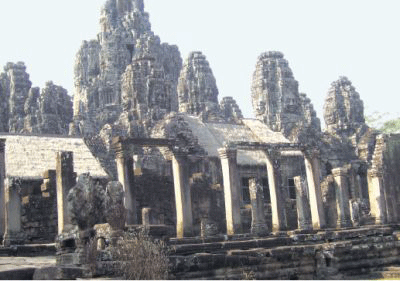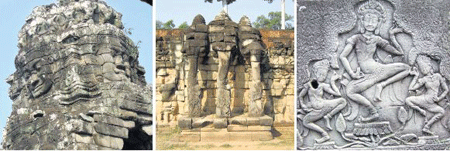
The half-smiling powerful faces of the Bayon temple, built by King Jayavarman VII of the Khmer regime in Cambodia in the late-12th or early-13th century, look down from above. They form part of the central State temple of Angkor Thom, his official city.
They are sensual, mysterious and exert a powerful pull on the mind and the senses, not just because of the appearance of the faces, but the sheer numbers and scale of the architecture. The faces jut out from the towers on all four sides on the upper terraces. They follow you wherever you go and interact with you . In fact, they interact with the observer in a silent fashion.
From a distance the temple looks like a jumble of stones and structures. But once the gaze settles, the pattern becomes clearer. Statistics of the number of faces are contradictory because many have been reduced to rubble — some say there are 216 now, while others say there are 57 towers, each with four faces looking out in all directions, seemingly omnipotent and omniscient.
The mystery deepens. Who did they represent? Accounts point to Jayavarman himself, validated by the idea that he considered himself a “devaraja”. He came to power relatively late in life and had an urge to complete his massive building programme quickly. He was also a follower of the Mahayana form of Buddhism; so could it have been a representation of Avalokiteswara?
However, earlier it was felt that it was Brahma, usually depicted with four faces (as in the temple of Ta Phrom, which is derived from Old Brahma).
Research points to the fact that this once humble, modest priest who renounced the throne twice, and then became the mightiest of all Khmer kings, imagined himself to be Buddha-like and installed these images as a form of self-worship.

It is a pyramid temple with three steep, successively receding platforms. I climb to the second level and approach the faces. They all sport the same patient, serene, slightly mocking smile. There is power and beauty, and an austere masculine grace in the smile.
But it is not just the faces that strike a note of amazement. The two galleries — the upper and inner — have a plethora of bas reliefs. The outer one has historical events and scenes from everyday life, naval struggles, an open-air market, a cockfight, military processions and so on.
The inner, supposed to be the addition of a later king who embraced Hinduism, has the trimurti, apsaras, Ravana and Garuda. I am fascinated by the apsaras, the celestial maidens of Indra’s court, also known as the heavenly dancers, and even more delighted when I see a bridal couple preparing for a photo shoot. She looks so much like an apsara as she puts on her garments and I see the crown of flowers lying on the parapet.
There is also the pictorial depiction of the Leper King, whose terrace is in Angkor Thom, and there are legends associated with it. Our guide tells us that he contracted leprosy when a serpent he attacked and killed spewed venom all over him. Another story says that he is Yama, god of death and judgement.
Some say it is Kubera with leprosy. Our guide also said that it is the place of cremation, which lends some credence to the Yama statue theory. The terrace is prolific with carvings of serried ranks of celestials.
The road to the south from the Bayon is lined with 54 colossal images of the gods, and an equal number of gods from the underworld on the road to the north. They are all pulling on the body of the cosmic naga, churning the ocean of milk to get the elixir of immortality. These figures are rather crudely carved as compared to the bas reliefs, but somehow they heighten the dramatic imagery.
I refuse to go up the third level of the Bayon. I do not know whether I want to see the statues any closer. They retain enough mystery and are compelling even at the second level.
Source : http://www.thehindubusinessline.com




